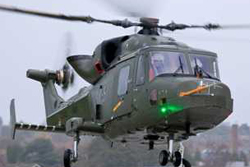 AgustaWestland, a Finmeccanica company, announced that the first AW159 multi-role military helicopter successfully completed its maiden flight at AgustaWestland’s Yeovil, U.K., facility with chief test pilot Donald Maclaine at the controls. The aircraft completed a range of general handling checks during the flight and performed as expected. It will be joined by two more aircraft in 2010 to complete the flight testing of the AW159 and the wide range of equipment the aircraft will carry.
AgustaWestland, a Finmeccanica company, announced that the first AW159 multi-role military helicopter successfully completed its maiden flight at AgustaWestland’s Yeovil, U.K., facility with chief test pilot Donald Maclaine at the controls. The aircraft completed a range of general handling checks during the flight and performed as expected. It will be joined by two more aircraft in 2010 to complete the flight testing of the AW159 and the wide range of equipment the aircraft will carry.
The AW159 is powered by two new generation LHTEC (a joint venture between Rolls Royce and Honeywell) CTS800 engines, each capable of continuously producing 1281 shp, giving the aircraft exceptional hot and high performance. The aircraft has an all-up mass of 5,790 kg with a built-in capability to increase that to 6,250 kg. The cockpit includes a fully integrated display system.
AgustaWestland CEO Giuseppe Orsi said, “The successful first flight of the AW159 is a great company achievement. Designed and developed to meet the U.K. MoD’s demanding requirements for a multi-role military helicopter, the AW159 will be the most cost-effective, capable, and advanced helicopter in its class. Our highly skilled engineers and technicians can be proud to have achieved this remarkable result on schedule and on budget, so confirming our commitment to maintaining critical design, engineering, and technological know-how in the U.K. to go on effectively supporting the MoD.”
The maiden flight of the AW159, which will be known as Lynx Wildcat in U.K. military service, marks a major milestone in the development of this new six-ton multi-role military helicopter, 62 of which have been ordered by the U.K. Ministry of Defence for the Army and Royal Navy, to perform both land and maritime missions. The first aircraft will be delivered in 2011 with the aircraft becoming fully operational with the Army in 2014 and the Royal Navy in 2015.


